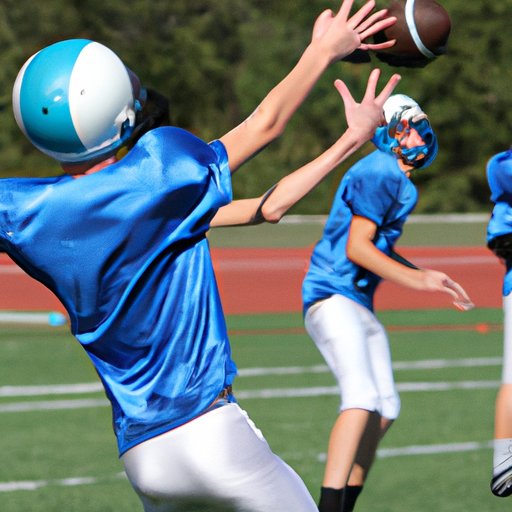Introduction
Throwing a football is an essential skill for any aspiring football player. Whether you’re a quarterback or a wide receiver, being able to make an accurate throw can be the difference between winning and losing a game. But throwing a football isn’t just about power – it also requires precision, technique, and form. In this article, we’ll break down the fundamentals of throwing a football, offer tips for athletes at different skill levels, and provide advice on how to correct common mistakes. By the end of this article, you’ll have the knowledge and tools you need to become a better football player.
The fundamentals of throwing a football
Before you can throw a football effectively, you need to master the basics. The three key components of a good throw are grip, stance, and delivery.
Grip
The grip is the foundation of a good throw. Your fingers should be spread apart over the laces, with your index finger extended slightly above the other fingers. Your thumb should be underneath the ball, and your hand should be positioned on the back half of the ball.

Stance
Your stance is crucial for maintaining balance and generating power. Start by standing with your feet shoulder-width apart, with your non-throwing foot slightly in front of the other foot. Bend your knees slightly, and keep your weight centered on the balls of your feet.

Delivery
The delivery is the actual act of throwing the football. As you bring the ball back to your throwing shoulder, step forward with your non-throwing foot and rotate your hips in the direction of the throw. As you release the ball, follow through with your throwing arm and extend it toward your target.

Tips for athletes of different skill levels
Whether you’re a beginner or an experienced player, there’s always room for improvement when it comes to throwing a football. Here are some tips for athletes at different skill levels:
Beginners
If you’re just starting out, focus on mastering the fundamentals. Spend time practicing your grip, stance, and delivery until they become second nature. Don’t worry too much about distance or power – the most important thing at this stage is to develop proper form and technique.
Intermediates
Once you’ve mastered the basics, it’s time to start working on your accuracy. Set up targets around the field and practice hitting them with your throws. Experiment with different types of passes, such as the spiral, lob, and bullet pass. Focus on maintaining a consistent release point and follow-through.
Experts
If you’re already an experienced football player, it’s time to start challenging yourself. Work on perfecting your footwork and developing a quicker release. Experiment with more advanced passes, such as the pump fake and screen pass. Consider working with a coach or trainer to identify areas of improvement and develop a personalized training plan.
Common mistakes and how to correct them
Even the best football players make mistakes from time to time. Here are some common mistakes to watch out for, and how to correct them:
Mistake: Throwing off-balance
If you’re throwing off-balance, your accuracy will suffer. Make sure to keep your weight centered and your feet planted when you release the ball. Work on improving your footwork and developing a strong base to support your throws.
Mistake: Over/under-throwing
If you’re consistently over- or under-throwing your targets, it’s a sign that you need to work on your power and delivery. Experiment with different grips and follow-throughs to find what works best for you. Practice throwing at varying distances to develop consistency and accuracy.
Mistake: Poor grip
The grip is the foundation of a good throw. If your grip is off, it can throw off your entire delivery. Make sure to keep your fingers spread and your thumb underneath the ball. Experiment with different finger positions to find what works best for you.
Types of passes and when to use them
There are several different types of passes you can use when throwing a football. Each type has its own strengths and weaknesses, and it’s important to know when to use each one:
The spiral pass
The spiral pass is the most common type of pass used in football. It’s characterized by a tight, spinning motion that helps it travel farther and with greater accuracy. Use a spiral pass when you need to throw the ball a long distance or hit a target with precision.
The lob pass
The lob pass is a high-arching pass that allows the receiver to run under the ball and catch it in stride. Use a lob pass when the receiver is open and you want to lead them downfield.
The bullet pass
The bullet pass is a high-speed pass that travels in a straight line. Use a bullet pass when you need to get the ball to the receiver quickly and with greater force.
Drills and exercises for improving throwing skills
There are many drills and exercises that can help you improve your throwing skills. Here are just a few examples:
Three-step drop
With a three-step drop, you take three steps back from the line of scrimmage before throwing the ball. This drill helps you work on your footwork and timing.
Target practice
Set up targets around the field and practice hitting them with your throws. This drill helps you work on your accuracy and consistency.
Resistance band throws
Attach a resistance band to a stationary object and practice throwing while holding onto the other end of the band. This drill helps you develop arm strength and power.
Conclusion
Throwing a football is an essential skill for any football player. Whether you’re a beginner or an expert, there’s always room for improvement. By mastering the fundamentals, practicing regularly, and incorporating drills and exercises into your routine, you can become a better and more effective football player. Keep challenging yourself, and don’t be afraid to seek out additional resources and training if you need it.
